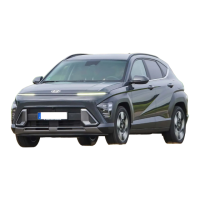2
2-13
Tires And Wheels
• It is permissible to add 3 psi (20 kPa) to the standard tire pressure specification if colder
temperatures are expected soon.
Tires typically lose 1 psi (7 kPa) for every 12 °F (7 °C) temperature drop. If extreme
temperature variations are expected, recheck your tire pressure as necessary to keep
them properly inflated.
• Tire inflation pressures may differ depending on changes in elevation (about 2.4 psi (10
kPa) for every 1 mile (1.6 km) elevation change). If driving in areas of higher or lower
elevation, be sure to check and adjust for proper tire inflation.
• Do not exceed the maximum inflation pressure, as found on the sidewall of the tire(s).
CAUTION
When replacing tires, ALWAYS use the same size, type, brand, construction, and tread
pattern supplied with the vehicle. If not, it can damage the related parts or make it work
irregularly.
Items Tire size Wheel size
Inflation pressure psi (kPa)
Wheel nut
torque lbf·ft
(kgf·ft, N ·m)
Normal load Maximum load
Front Rear Front Rear
Full size tire
215/60R17 7.0J X 17 36 (250)
79-94
(11-13, 107-127)
215/55R18 7.0J X 18 33 (230)
235/45R19 7.5J X 19 33 (230)
Compact
spare tire
(if equipped)
T145/90D16 4.0T X 16 60 (420)
Hyundai_SX2_en_US.book Page 13

